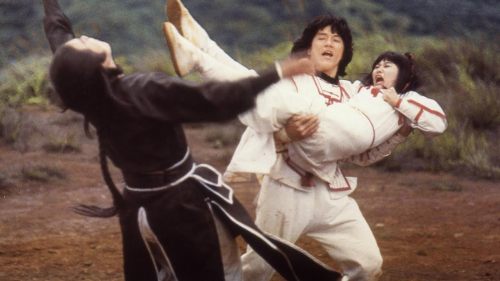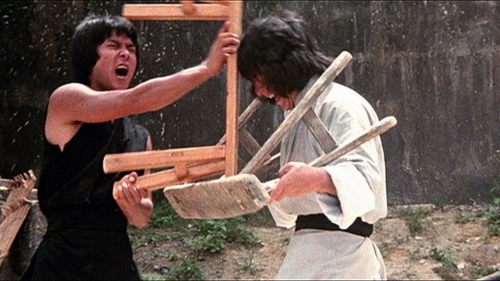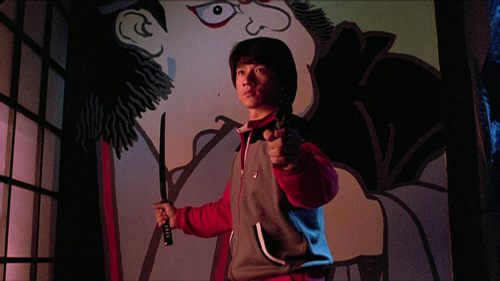The Best from Criterion in 2010
1. Stagecoach (Best of the Best)
Decent prints of the movie simply don’t exist. Suffering from massive popularity at its time of release, and massive print duplication as a result, the movie never looked very good after its initial few presentations. Compared to the 2006 DVD and every version of the movie I’ve ever seen, Criterion’s HD remastering and cleanup of the movie is nothing short of a revelation.
2. The Night of the Hunter (Best of the Best)
A perfect example of a B&W film where the lack of color is undeniably the underpinning of the entire picture’s visual design. Rick, thick contrast is present throughout, putting the old DVD to shame and then some. Stanley Cortez’s photography finally gets the love it deserves.
3. Modern Times (Best of the Best)
The previous MK2/WB DVD featured interlaced video, a sin even back then. This upgrade reproduces the quality of the archival prints I’ve seen for years now in rep screenings.
4. Bigger Than Life (Best of the Best)
It’s about time Nicholas Ray found his way into the collection of auteurs curated by the Criterion folks. As usual, they took a film that wouldn’t otherwise soon find its way to a Blu-ray release (much less of this caliber) and knocked it out of the park.
5. Che (Best of the Best)
A very recent film shot on a RED camera wouldn’t seem to be the hardest of jobs when it comes to dumping to HD for home video, but I’ve seen studio movies that were shot on RED look like garbage when put on home video. Soderbergh’s epic gets the right end of the stick.
6. Paths of Glory
A great deal of the movie takes place in trenches, and the grit and grime really pops, no longer lost in lossy blur. The background detail in the big house scenes is stunning.
7. Vivre Sa Vie
They’ve always treated Godard well, but this one is notable for more than just a regular bang-up job. In case you aren’t familiar with the film, it includes a sequence from Dreyer’s The Passion of Joan of Arc. Not only is it another sharp, clean, and grainy black & white transfer of this film, but it gives a glimpse at one of the great films (silent or not) in HD.
8. The Magician
They get extra props for giving the first-class treatment to one of Bergman’s less-celebrated masterworks. In an off-the-record conversation, Guillermo del Toro touted this one to me as one of his favorite of their releases this year.
9. Red Desert
Desolate, beautiful, and devastating, Antonioni’s first color film looks better than you could imagine before seeing it.
10. Cronos
A dark film, bathed in blues and pinks and shadows, making this film look good isn’t a simple task. I wasn’t a fan of the look on the DVD that came out a few years ago, but this overdoes my expectations.
The 10 Best Video Transfers (DVD to Blu-ray Upgrades)
These titles were all previously available as DVDs, but got stunning new audio/video transfers in HD. All the supplements are the same, but the eye candy is cranked up big-time.
1. The Red Shoes (Best of the Best)
The featurette about the restoration on this release includes none other than Scorsese explaining how everything went down.
2. Days of Heaven (Best of the Best)
If you’ve seen the film, you know what I mean when I mention “the fire”. This and Red Shoes are two of the best color transfers available on Blu-ray.
3. Videodrome (Best of the Best)
Many came to know the movie on grimy, muddy VHS. Having since seen a print of it, I can attest that this transfer conveys every last bit of detail I felt creep into the flesh of my eyes at that screening. I didn’t know it could freak me out any more.
4. M (Best of the Best)5. Seven Samurai (Best of the Best) In both of these cases, these titles have had two DVD editions prior to their new Blus, and each step was a substantial jump forward in how good these movies looked on home video. Here, stunning contrast and detail in the fabrics and textures seen in both films take on a whole new life.
6. Breathless (Best of the Best)
A much more recent addition to the collection, Breathless benefited from this year marking its 50th anniversary and a major restoration.
7. Yojimbo/Sanjuro
Two films that are rarely not shown together, they have often been less cared-for than Seven Samurai. That’s not the case here.
8. Black Narcissus
A restoration done on the coattails of Shoes, Narcissus makes for a great double feature lead-in for Shoes.
9. Charade
Yes, you can get some public domain junk version of this on DVD for a buck. If you love the movie, here it is looking like a newly-struck film print on your TV.
10. The Leopard
Criterion’s gleaming, golden clean-up of what for some time was their top seller is worth double-dipping on. The list where I put this transfer of The Leopard tenth is one full of Sophie’s Choices indeed.
The 8 Best and Most Important Box Sets
1. America Lost and Found: The BBS Story (Best of the Best)(Head/Easy Rider/Five Easy Pieces/Drive, He Said/A Safe Place/The Last Picture Show/The King of Marvin Gardens)
Rider, Pieces, and Picture Show all generally stand on their own, but this set gives greater context to them and other important films from the same movement. Until now, the American New Wave hasn’t been given this kind of expert context. My review here goes into considerable depth, so suffice to say here that this was both the most unexpected and welcome Criterion announcement of the year. It’s one of the new jewels in Criterion’s crown.
2. Roberto Rosselini’s War Trilogy (Best of the Best)
(Rome Open City, Paisan, Germany Year Zero)
This is technically a tie for first, but I favored the other based on the huge amount of extras and content, so sue me. These three films were made in the closing days of and the couple of years following WWII. Shot on war-torn locations using a combination of actors and regular Joes, they remain one of the most striking records of the war and the neorealist style that the films spawned. Criterion’s restored transfers of all three films are pretty miraculous, considering the disrepair they’ve been in for decades. Commentary, vintage intros from the director, documentaries, and retrospective featurettes round out one of the most historically significant titles of the year.
3. Three Silent Classics by Josef von Sternberg (Best of the Best)(Underworld/The Last Command/The Docks of New York)
Here resides a trio of the most influential silent films that have gone unseen by the last few generations of cineastes. They’re so good that even those usually scared off by “black & white” or “silent” shouldn’t worry. Sternberg is best-remembered for the films he did with Marlene Dietrich, but these silents were made just before the big switch over to talkies. This trio influenced droves of directors making similarly-themed films. This extended to the last years of silent movies in other countries, since not everyone jumped to talkies as quickly as the US. Two scores are available for each film.
4. The Only Son/There Was a Father: Two Films by Yasujiro Ozu(The Only Son/There Was a Father)
These two films are among the most often overlooked and hard to find features from Japanese master Yasujiro Ozu, complete with great interviews and essays that serve as great primers on Ozu for the uninitiated.
5. Eclipse 22: Presenting Sacha Guitry
(The Story of a Cheat, The Pearls of the Crown, Désiré, Quadrille)
6. Eclipse 24: The Actuality Dramas of Allan King
(Warrendale, A Married Couple, Come on Children, Dying at Grace)
These sets were both introductions to fascinating directors largely unknown even to the art nerds out there. Guitry was an influence on none other than Orson Welles, among others. Alaln King is something of a hidden gem, with a career spanning five decades that included these brilliant cinema verité-style documentaries.
7. Eclipse 21: Oshima’s Outlaw Sixties(Pleasures of the Flesh, Violence at Noon, Sing a Song of Sex, Japanese Summer: Double Suicide, Three Resurrected Drunkards)
8. Eclipse 23: First Films of Akira Kurosawa
(Sanshiro Sugata, The Most Beautiful, Sanshiro Sugata Part Two, The Men Who Tread on the Tiger’s Tail)
Oshima is still penetrating the young art dork world, and I’m so glad this particular bundle of titillating titles are packed as a set. The Kurosawa titles were previously out as part of the mammoth AK 100 box set, but this puts them available separately for the first time.
The 10 Best Single Releases
It’s my firm belief that any or all of the below releases deserve a spot on any serious cineaste’s shelf. Consider them all worthy of a “blind buy”. It just so happens that a few of them are among my favorite films.
1. The Night of the Hunter
I consider Night of the Hunter to be one of the great achievements of American cinema. The most substantial supplemental feature, “Charles Laughton Directs The Night of the Hunter”, gets a disc all to itself. Laughton only directed one picture (this one), and seeing the wealth of dailies, outtakes, and reshoots on display here is like being behind the scenes for Citizen Kane or The Magnificent Ambersons.
2. Stagecoach
One of the most re-watchable films (let alone westerns), and for good reason. Looks great, and the extras are all worth revisiting.
3. Modern Times
If this is any indication of what’s to come from the Chaplin archives, then we’re in for one of the most comprehensive and satisfying treatments of a single director in the history of home video.
4. Che
Politics be damned, the film is amazing. It’s sad that we’re at a point where people demand nothing longer than 100 minutes, and look to the cinema for just cheap escapism rather than something that makes their grey matter work. Maybe home video is the last refuge of the thinking person’s cinema.
5. The Red Shoes
One of the great stories of life imitates art imitates life, everything from the original release is carried over and plenty more is added in.
6. The Thin Red Line
That there are deleted scenes on this release as well as a commentary (albeit not by the director) are miracles in and of themselves. Even better? Malick’s special request included here that the film be played “LOUD”.
7. House
The film gets the lion’s share of credit for its inclusion on this list, but the extra in which the filmmaker and his daughter talk about how the Toho of the late 1970’s tried to bury this film forever in the wake of unexpected success is brilliant.
8. Paths of Glory
More Kubrick in the Collection is always a good thing, and adding a solid commentary, interviews with longtime exec producer Jan Harlan and widow Christiane Kubrick, as well as a French TV piece about the military execution that inspired the film really show off how Criterion can treat a great film with the proper respect.
9. Cronos
One of Del Toro’s unfinished shorts was completed for this release, and more so than any other home video version of his film, the extras paint a rather comprehensive look at his birth as an artist.
10. Close-Up
I’m not including this because of the recent announcement that an Iranian filmmaker (Jafar Panahi) was jailed and is legally prohibited from making films, nor am I including it as some sort of political statement. The film is a great entry point into Iranian film, and the extras pick up with both the film’s subject and Kiarostami, its director, many years after the fact to intriguing effect. Hey Catfish, I got all the fraudster documentary/drama I need right here!
The 10 Best Extras
Soderbergh Admits That Cinema May No Longer be Relevant (Che)
In a moment of frankness, Steven Soderbergh runs headfirst into declaring that people don’t interact with the cinema in the way we once did. From the featurette in question: “I guess the point of some art is to illuminate. I guess… I just don’t see any evidence that it’s…happening. [he grimaces] Or, you know, it happens for ten minutes and then, you know…everybody’s thinking about where they wanna go eat”.
Yakima Canutt: Stuntman Supreme (Stagecoach)
I love that in addition to what you’d expect, they gave special coverage to Yakima Canutt, the stuntman seen on the cover and whose work contributed to two of the most well-known stunts in the history of cinema.
Charles Laughton Directs His Ass Off (The Night of the Hunter)
Over the last 20+ years, reels upon reels of rushes and outtakes have been painstakingly edited together by one guy, his wife, and various interns. I had no idea any of this stuff existed. Getting to hear Laughton directing the kids is a master class in directing children. Watching Mitchum cock up the “Love/Hate” story is absolutely fascinating stuff, where you get to see one of the best do his work. People who haven’t been on a movie set or in some sort of dramatic production of any sort may take Laughton’s candor with the kids or other actors as overly direct and commanding, but…that’s what directors do.
Scorsese on Restoration (The Red Shoes)
We get precious few minutes of Scorsese geeking out about the restoration process undergone to clean up one of his favorite films.
Del Toro Finishes an Incomplete Film (Cronos)
Guillermo never finished his short film Geometria…until now. The sound needed proper mixing, among other things. People might be surprised how many filmmakers as prominent as him have unfinished shorts.
Bordwell & Thompson on Ozu (Two Films by Yasujiro Ozu: The Only Son/There Was a Father)
Maybe you’ve never heard of Ozu. The only “old” Japanese director the average moviegoer or aspiring cineaste has even heard of is Kurosawa. Ozu was king of the domestic drama, and for me, is one of the best directors in cinematic history. Jokes are made about how he never moved the camera, but he never needed to. David Bordwell and Kristen Thompson are the husband/wife duo that have most extensively covered Ozu’s work (aside from Donald Richie) in the States. Their interviews on this set are among the most informative crash courses one could get on Ozu.
Jack Nicholson, A Symphony of Dicks, and The BBS Era (Drive, He Said)
I didn’t expect Jack Nicholson to ever say “I wanted to open it with a sequence called ‘A Symphony of Dicks’”. A porn director, maybe, but not Jack talking about his directorial debut.
Molly Haskell Interviews Henry Jaglom and Peter Bogdanovich, Who Wears a Tie For Once (America Lost and Found)
Almost beating Nicholson is a TV interview from the 70’s with one subject chain-smoking and an interviewer who admits she never finished watching one of the subjects’ movies (A Safe Place).
Chaplin on Skates Behind Glass (Modern Times)
They pulled the curtain back on how Chaplin managed the roller skating bit in the store. All it took was a couple of guys who worked on the original Star Wars movies.
The Jim Jarmusch Anti-Commentary (Mystery Train)
He doesn’t like to do commentary tracks at all. What he did instead was have Criterion solicit emailed questions, which he reads over a static screen image here…the day that the earthquake in Haiti was in the morning paper. He digresses about Avatar, and then jumps into 70 minutes of question-answering.
—————————-
Coming soon: speculation about the Criterion year to come!



